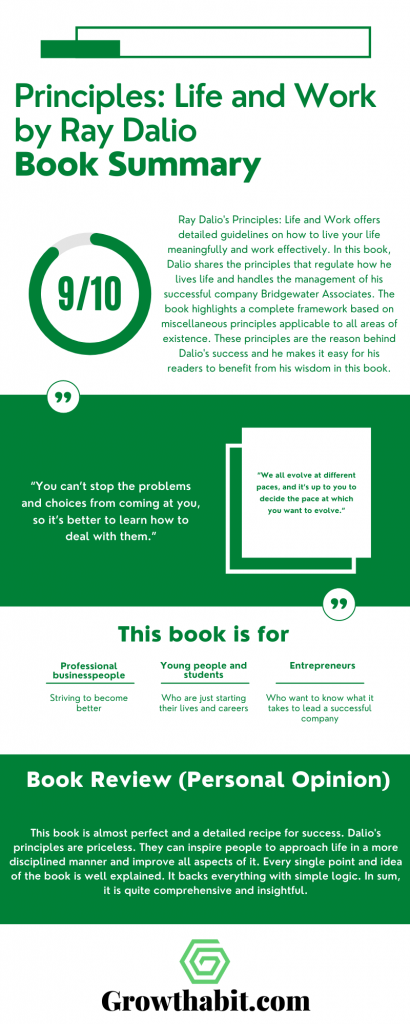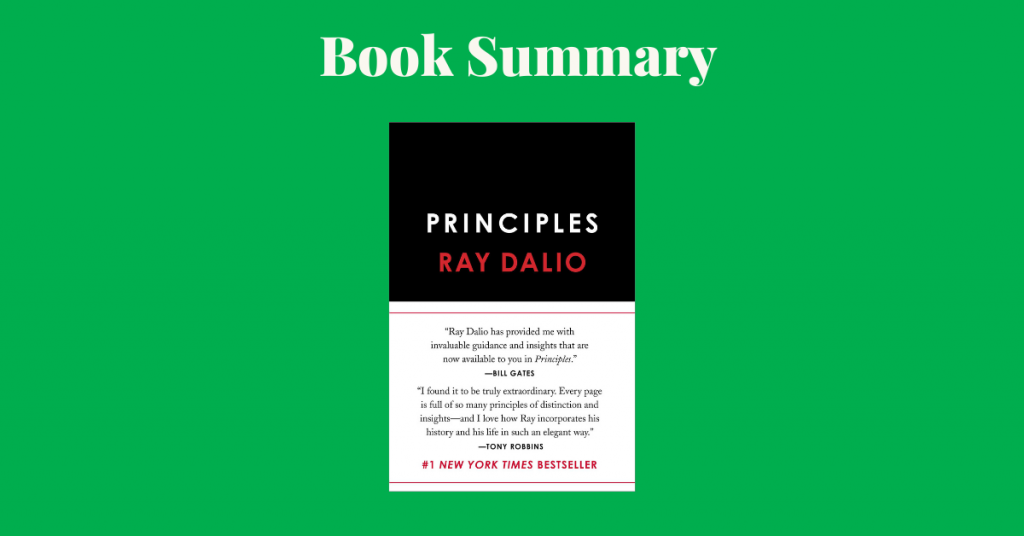Ray Dalio’s Principles: Life and Work offers detailed guidelines on how to live your life meaningfully and work effectively. In this book, Dalio shares the principles that regulate how he lives life and handles the management of his successful company Bridgewater Associates.
The book highlights a complete framework based on miscellaneous principles applicable to all areas of existence. These principles are the reason behind Dalio’s success and he makes it easy for his readers to benefit from his wisdom in this book.
Book Title: Principles: Life and Work
Author: Ray Dalio
Date of Reading: October 2017
Rating: 9/10
What Is Being Said In Detail
The book has three clearly constructed parts that are fit for both separate and collective reading.
Part 1: The Importance of Principles
Part 1 lays out the foundation for the entire book by underlining the objective and significance of being principled on an overall basis. In this part, Dalio shares the meaning of the term principles, the reason why he considers principles to be significant, and the way they are vital to accomplishing your goals in life.
Principles and Their Part in Our Success
This section tells us that our values personify what we hold important. Our principles let us shape our lives according to these values.
Principles are important because following them makes it possible for successful people to be successful. If people live without principles, they would need to respond to situations without taking their values into account. Subsequently, they would not know what to do to reach their goals.
Part 2: My Most Fundamental Life Principles
Part 2 shares Dalio’s basic life principles that dictate every single action of his life. In this part, he defines that the best way to connect with reality is to know its true nature and handle it to achieve your goals.
Dalio also uses this part to explain frequent mistakes made by people that bar them from achieving their goals.
Core Principles
This section tells us that a successful life is a combination of reality, dreams, and determination. The bottom line of Dalio’s most fundamental principles is that we need to evolve endlessly to be happy.
The next important principle is that we need both meaningful work and meaningful relationships to be satisfied.
Five Important Decision Trees
The five most important decision trees tell us that progress results from a combination of pain and reflection, it is important to acknowledge the actual truth instead of what we wish to be true, being good is more important than appearing good, weighing first, second and third order consequences instead of ignoring the last two can help a person reach their goal, and people who blame others for their problems and challenges cannot succeed in life.
You can achieve success by surrendering your ego, avoiding excuses, staying determined and having courage. Additionally, character is at the heart of everything.
Five-Step Process
The five-step process for reaching your goals in life entails setting your goals, recognizing and not bearing with the problems you face while pursuing those goals, diagnosing these problems, forming a plan that will help you handle these problems, and then performing the tasks specified in the plan.
Part 3: My Management Principles
Part 3 illuminates Dalio’s management principles the way they are being followed and executed at his organization Bridgewater.
He starts at the conceptual level and underlines how the people and culture of an organization mainly shape its outcomes. He then shares all relevant points for clarity.
Dalio’s Most Significant Management Principles
Some of the core principles that encompass Dalio’s all other principles include having faith in truth, designing a culture that allows mistakes but disallows a failure to recognize, assess and learn from these mistakes, finding harmony with truth and how to handle it, realizing that your most crucial decisions depend on who you choose to give responsibility to, understanding that people have uniquely different values, capabilities and skills, and recruiting the most suitable people because if you fail to do so, the consequences could be immense.
Others include managing your organization like you are designing and running a machine to reach your goals, investigating vigorously to know your expectations from the machine, assessing people correctly and not being kind while doing so, and letting people get trained and tested through experiences.
Such principles also underline that if someone is not good at their job, either give them another job or fire them.
Moreover, use the 5-step process to identify problems efficiently, diagnose to comprehend the root causes behind problems, rewind a little before proceeding ahead, map out your machine to reach your goals, adhere to your predefined path, understand the power of being aware of not being aware, let logic direct all your decisions, separate the significant from the insignificant, and synthesize.
Most Important Keywords, Sentences, Quotes:
INTRODUCTION
“Principles are concepts that can be applied over and over again in similar circumstances as distinct from narrow answers to specific questions.”
“Principles are ways of successfully dealing with the laws of nature or the laws of life.
Those who understand more of them and understand them well know how to interact with the world more effectively than those who know fewer of them or know them less well. Different principles apply to different aspects of life.”
“I also believe that those principles that are most valuable to each of us come from our own encounters with reality and our reflections on these encounters – not from being taught and simply accepting someone else’s principles.”
PART 1: THE IMPORTANCE OF PRINCIPLES
1) WHAT ARE PRINCIPLES?
“Your values are what you consider important, literally what you “value.” Principles are what allow you to live a life consistent with those values. Principles connect your values to your actions; they are beacons that guide your actions, and help you successfully deal with the laws of reality. It is to your principles that you turn when you face hard choices.”
2) WHY ARE PRINCIPLES IMPORTANT?
“All successful people operate by principles that help them be successful. Without principles, you would be forced to react to circumstances that come at you without considering what you value most and how to make choices to get what you want. This would prevent you from making the most of your life.”
3) WHERE DO PRINCIPLES COME FROM?
“Sometimes we forge our own principles and sometimes we accept others’ principles, or holistic packages of principles, such as religion and legal systems.”
“Adopting pre-packaged principles without much thought exposes you to the risk of inconsistency with your true values.”
4) DO YOU HAVE PRINCIPLES THAT YOU LIVE YOUR LIFE BY? WHAT ARE THEY?
“Your principles will determine your standards of behavior. When you enter into relationships with other people, your and their principles will determine how you interact. People who have shared values and principles get along.”
5) HOW WELL DO YOU THINK THEY WILL WORK, AND WHY?
“Those principles that are most valuable come from our own experiences and our reflections on those experiences. Every time we face hard choices, we refine our principles by asking ourselves difficult questions.”
“So, as I believe that adopting pre-packaged principles without much thought is risky, I am asking you to join me in thoughtfully discussing the principles that guide how we act. When considering each principle, please ask yourself, “Is it true?” ”
PART 2: MY MOST FUNDAMENTAL LIFE PRINCIPLES
“Time is like a river that will take you forward into encounters with reality that will require you to make decisions. You can’t stop the movement down this river, and you can’t avoid the encounters. You can only approach these encounters in the best way possible.
That is what this part is all about.”
WHERE I’M COMING FROM
“So what I really wanted to do now was beat the market. I just had to figure out how to do it. The pursuit of this goal taught me:”
“So in 1975, after a quick two-year stint on Wall Street after school, I started Bridgewater. Soon after, I got married and began my family.”
“Through this time and till now I followed the same basic approach I used as a 12-year-old caddie trying to beat the market, i.e., by 1) working for what I wanted, not for what others wanted me to do; 2) coming up with the best independent opinions I could muster to move toward my goals; 3) stress-testing my opinions by having the smartest people I could find challenge them so I could find out where I was wrong; 4) being wary about overconfidence, and good at not knowing; and 5) wrestling with reality, experiencing the results of my decisions, and reflecting on what I did to produce them so that I could improve.”
“Since I started Bridgewater, I have gained a lot more experience that taught me a lot more, mostly by making mistakes and learning from them. Most importantly:”
“I learned that failure is by and large due to not accepting and successfully dealing with the realities of life, and that achieving success is simply a matter of accepting and successfully dealing with all my realities.”
“I learned that finding out what is true, regardless of what that is, including all the stuff most people think is bad—like mistakes and personal weaknesses—is good because I can then deal with these things so that they don’t stand in my way.”
“I learned that there is nothing to fear from truth. While some truths can be scary—for example, finding out that you have a deadly disease— knowing them allows us to deal with them better.”
“I learned that being truthful was an extension of my freedom to be me.”
“I learned that I want the people I deal with to say what they really believe and to listen to what others say in reply, in order to find out what is true.”
“I learned that everyone makes mistakes and has weaknesses and that one of the most important things that differentiates people is their approach to handling them.
I learned that there is an incredible beauty to mistakes, because embedded in each mistake is a puzzle, and a gem that I could get if I solved it, i.e., a principle that I could use to reduce my mistakes in the future.”
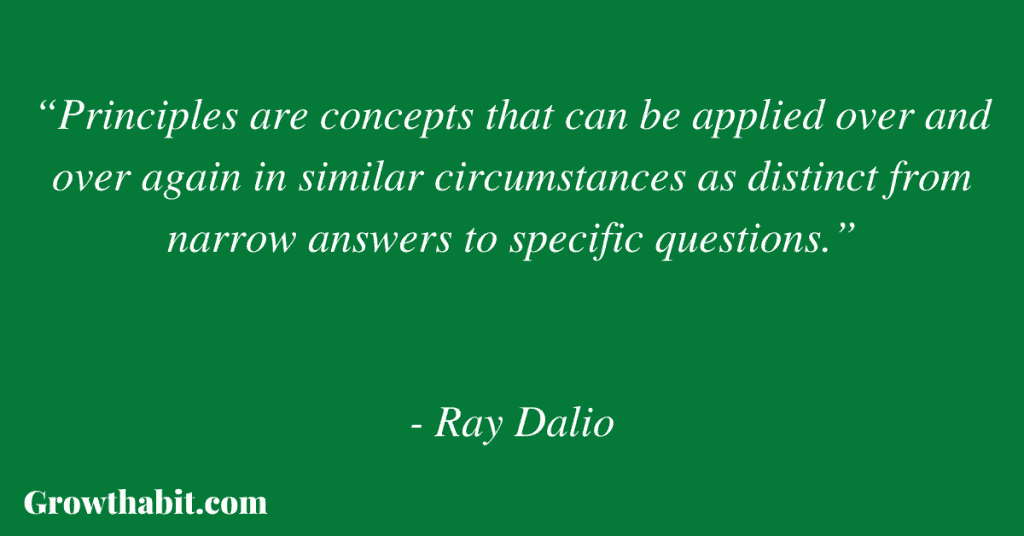
“I learned that the popular picture of success—is an inaccurate picture of the typical successful person.
I met a number of great people and learned that none of them were born great—they all made lots of mistakes and had lots weaknesses— and that great people become great by looking at their mistakes and weaknesses and figuring out how to get around them.”
“In short, I learned that being totally truthful, especially about mistakes and weaknesses, led to a rapid rate of improvement and movement toward what I wanted.”
“While most others seem to believe that learning what we are taught is the path to success, I believe that figuring out for yourself what you want and how to get it is a better path.”
“I believe that having questions is better than having answers because it leads to more learning.”
“I believe that most learning comes via making mistakes and reflecting on them.”
“While most others seem to believe that finding out about one’s weaknesses is a bad thing, I believe that it is a good thing because it is the first step toward finding out what to do about them and not letting them stand in your way.
“I believe that pain is required to become stronger.”
MY MOST FUNDAMENTAL PRINCIPLES
“Truth—more precisely, an accurate understanding of reality—is the essential foundation for producing good outcomes.”
“I believe that evolution, which is the natural movement toward better adaptation, is the greatest single force in the universe, and that it is good.”
“I believe that the desire to evolve, i.e., to get better, is probably humanity’s most pervasive driving force.”
“In other words, the sequence of 1) seeking new things (goals); 2) working and learning in the process of pursuing these goals; 3) obtaining these goals; and 4) then doing this over and over again is the personal evolutionary process that fulfills most of us and moves society forward.”
“I believe that pursuing self-interest in harmony with the laws of the universe and contributing to evolution is universally rewarded.”
“We all have things that we value that we want and we all have strengths and weaknesses that affect our paths for getting them. The most important quality that differentiates successful people from unsuccessful people is our capacity to learn and adapt to these things.”
THE PERSONAL EVOLUTIONARY PROCESS
“I believe that life consists of an enormous number of choices that come at us and that each decision we make has consequences, so the quality of our lives depends on the quality of the decisions we make.”
“I believe that the way we make our dreams into reality is by constantly engaging with reality in pursuit of our dreams and by using these encounters to learn more about reality itself and how to interact with it in order to get what we want—and that if we do this with determination, we almost certainly will be successful. In short:
Reality + Dream + Determination = A Successful Life
So what is success? I believe that it is nothing more than getting what you want—and that it is up to you to decide what that is for you.”
“What is essential is that you are clear about what you want and that you figure out how to get it.
However, there are a few common things that most people want.
As I mentioned, for most people success is evolving as effectively as possible, i.e., learning about oneself and one’s environment and then changing to improve. Personally, I believe that personal evolution is both the greatest accomplishment and the greatest reward.”
“Also, for most people happiness is much more determined by how things turn out relative to their expectations rather than the absolute level of their conditions.”
“This basic principle suggests that you can follow one of two paths to happiness: 1) have high expectations and strive to exceed them, or 2) lower your expectations so that they are at or below your conditions. Most of us choose the first path, which means that to be happy we have to keep evolving.
Another principle to keep in mind is that people need meaningful work and meaningful relationships in order to be fulfilled.”
“Regardless of others’ principles, you will need to decide for yourself what you want and go after it in the best way for you.”
YOUR MOST IMPORTANT CHOICES
“As we head toward our goals we encounter an enormous number of choices that come at us, and each decision we make has consequences.
So, the quality of our lives depends on the quality of the decisions we make. We literally make millions of decisions that add up to the consequences that are our lives.”
“Of these millions, I believe that there are five big types of choices that we continually must make that radically affect the quality of our lives and the rates at which we move toward what we want.
Choosing well is not dependent on our innate abilities such as intelligence or creativity, but more on what I think of as character. For this reason, I believe that most people can make the right choices.”
“The following five decision trees show these choices. I believe that those who don’t move effectively to their goals do the things on the top branches, and those who do move to them most quickly do the things on the bottom branches.”
FIRST:
“It is a fundamental law of nature that to evolve one has to push one’s limits, which is painful, in order to gain strength—whether it’s in the form of lifting weights, facing problems head-on, or in any other way.”
“Pain + Reflection = Progress
SECOND:
“People who confuse what they wish were true with what is really true create distorted pictures of reality that make it impossible for them to make the best choices.
They typically do this because facing “harsh realities” can be very difficult. However, by not facing these harsh realities, they don’t find ways of properly dealing with them. And because their decisions are not based in reality, they can’t anticipate the consequences of their decisions.
In contrast, people who know that understanding what is real is the first step toward optimally dealing with it make better decisions.”
“How much do you let what you wish to be true stand in the way of seeing what is really true?”
THIRD:
“People who worry about looking good typically hide what they don’t know and hide their weaknesses, so they never learn how to properly deal with them and these weaknesses remain impediments in the future.”
“People who are interested in making the best possible decisions rarely are confident that they have the best possible answers.
So they seek to learn more (often by exploring the thinking of other believable people, especially those who disagree with them) and they are eager to identify their weaknesses so that they don’t let these weaknesses stand in the way of them achieving their goals.”
“How much do you worry about looking good relative to actually being good?”
FOURTH:
“People who overweigh the first-order consequences of their decisions and ignore the effects that the second- and subsequent-order consequences will have on their goals rarely reach their goals.”
“By contrast, people who choose what they really want, and avoid the temptations and get over the pains that drive them away from what they really want, are much more likely to have successful lives.”
“How much do you respond to 1st order consequences at the expense of 2nd and 3rd order consequences?”
FIFTH:
“People who blame bad outcomes on anyone or anything other than themselves are behaving in a way that is at variance with reality, and subversive to their progress.”
“Successful people understand that bad things come at everyone and that it is their responsibility to make their lives what they want them to be by successfully dealing with whatever challenges they face. Successful people know that nature is testing them, and that it is not sympathetic.”
“How much do you let yourself off the hook rather than hold yourself accountable for your success?”
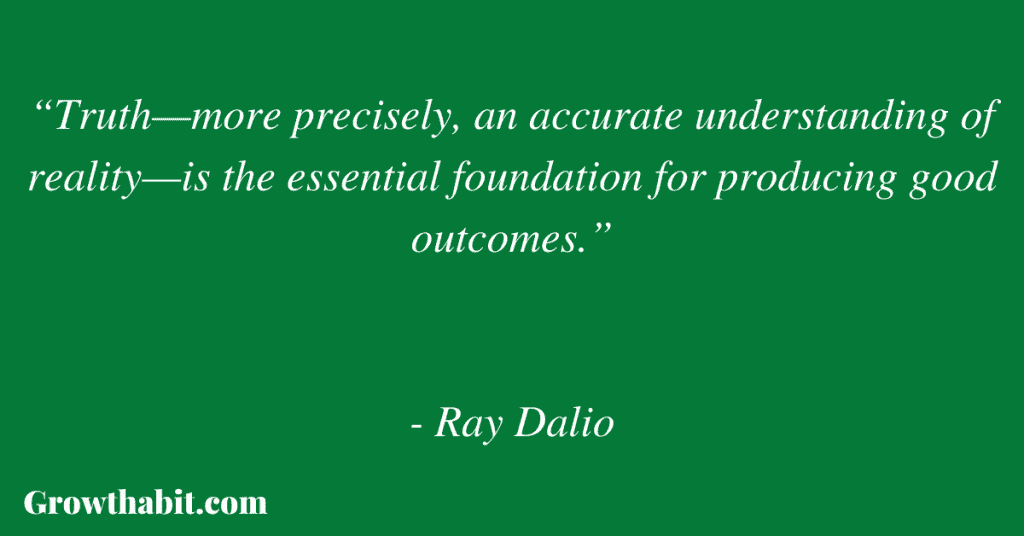
“In summary, I believe that you can probably get what you want out of life if you can suspend your ego and take a no-excuses approach to achieving your goals with open-mindedness, determination, and courage, especially if you rely on the help of people who are strong in areas that you are weak.”
“If I had to pick just one quality that those who make the right choices have, it is character. Character is the ability to get one’s self to do the difficult things that produce the desired results.
In other words, I believe that for the most part, achieving success—whatever that is for you—is mostly a matter of personal choice and that, initially, making the right choices can be difficult.”
“I don’t believe that limited abilities are an insurmountable barrier to achieving your goals, if you do the other things right.”
YOUR TWO YOUS AND YOUR MACHINE
“Those who are most successful are capable of “higher level thinking” —i.e., they are able to step back and design a “machine” consisting of the right people doing the right things to get what they want.
They are able to assess and improve how their “machine” works by comparing the outcomes that the machine is producing with the goals.”
“That schematic is meant to convey that your goals will determine the “machine” that you create to achieve them; that machine will produce outcomes that you should compare with your goals to judge how your machine is working.
Your “machine” will consist of the design and people you choose to achieve the goals.”
“I call it “higher level thinking” because your perspective is of one who is looking down on at your machine and yourself objectively,”
“The biggest mistake most people make is to not see themselves and others objectively. If they could just get around this, they could live up to their potentials.”
“How much do you intellectually agree with what I just said?
How good are you in approaching life as a “higher level thinker” rather than as a doer?
How much would you like to get better at this?
How much do you think that reading this is a waste of time?”
MY 5-STEP PROCESS TO GETTING WHAT YOU WANT OUT OF LIFE
“First, you have to choose your goals, which will determine your direction. Then you have to design a plan to achieve your goals. On the way to your goals, you will encounter problems. As I mentioned, these problems typically cause pain.
The most common source of pain is in exploring your mistakes and weaknesses. You will either react badly to the pain or react like a master problem solver. That is your choice.
To figure out how to get around these problems you must be calm and analytical to accurately diagnose your problems. Only after you have an accurate diagnosis of them can you design a plan that will get you around your problems. Then you have to do the tasks specified in the plan.”
“In other words, “The Process” consists of five distinct steps:
Have clear goals.
Identify and don’t tolerate the problems that stand in the way of achieving your goals.
Accurately diagnose these problems.
Design plans that explicitly lay out tasks that will get you around your problems and on to your goals.
Implement these plans—i.e., do these tasks.”
“1) You must approach these as distinct steps rather than blur them together.”
“2) Each of these five steps requires different talents and disciplines.”
“3) It is essential to approach this process in a very clear-headed, rational way rather than emotionally.”
“To help you do these things well—and stay centered and effective rather than stressed and thrown off by your emotions—try this technique for reducing the pressure: treat your life like a game or a martial art.”
THE 5 STEPS CLOSE-UP
“1) Setting goals.”
“2) Identifying and not tolerating problems.”
“3) Diagnosing the problems.”
“4) Designing the plan (determining the solutions).”
“5) Doing the tasks.”
WEAKNESSES DON’T MATTER IF YOU FIND SOLUTIONS
“Most importantly, ask yourself what is your biggest weakness that stands in the way of what you want.”
“As you design and implement your plan to achieve your goals, you may find it helpful to consider that:
Life is like a game where you seek to overcome the obstacles that stand in the way of achieving your goals;
You get better at this game through practice;
The game consists of a series of choices that have consequences;
You can’t stop the problems and choices from coming at you, so it’s better to learn how to deal with them;
You have the freedom to make whatever choices you want, though it’s best to be mindful of their consequences;
The pain of problems is a call to find solutions rather than a reason for unhappiness and inaction, so it’s silly, pointless, and harmful to be upset at the problems and choices that come at you (though it’s understandable);
We all evolve at different paces, and it’s up to you to decide the pace at which you want to evolve;
The process goes better if you are as accurate as possible in all respects, including assessing your strengths and weaknesses and adapting to them.”
PART 3: MY MANAGEMENT PRINCIPLES
“I believe that to have a great company you have to make two things great —the culture and the people. If these two things are great your organization can navigate the twists and turns to get you where you want to go.”
“Every organization works like a machine to achieve its goals. This machine produces outcomes.
By comparing the outcomes to the goals, those running the machine can see how well the machine is working. This is the feedback loop that those who are responsible for the machine need to run well in order to improve the machine.
Based on the feedback, the machine can be adjusted to improve. The machine consists of two big parts—the culture and the people. If the outcomes are inconsistent with the goals, something must be wrong with the machine, which means that something must be wrong with the culture and/or the people.
By diagnosing what is wrong, designing improvements and implementing those improvements, the machine will evolve.”

“The more frequently and effectively those in the machine go through this process, the more rapidly they and the machine will evolve.
An effective evolutionary process looks like this—i.e., lots of quality feedback loops produces a steep upward trajectory.”
“An ineffective evolutionary process—i.e., one in which mistakes are infrequently looked at and weaknesses are not well identified—looks like that shown below, i.e., fewer and/or less effective feedback loops produces a slower upward trajectory.”
BRIDGEWATER’S CULTURE AND PEOPLE
“, I want Bridgewater to be a company in which people collectively…
…1) work for what they want and not for what others want of them. …2) come up with the best independent opinions they can muster to move toward their goals,
…3) stress-test their opinions by having the smartest people they can find to challenge them so they can find out where they are wrong,
…4) are wary about overconfidence, and good at not knowing
…5) wrestle with reality, experiencing the results of their decisions, and reflecting on what they did to produce them so that they can improve.”
SUMMARY AND TABLE OF PRINCIPLES TO GET THE CULTURE RIGHT…
“1) Trust in Truth”
“3) Create an environment in which everyone has the right to understand what makes sense and no one has the right to hold a critical opinion without speaking up about it.”
“7) Don’t tolerate dishonesty.”
“8) Create a Culture in Which It Is OK to Make Mistakes but Unacceptable Not to Identify, Analyze, and Learn From Them”
“9) Recognize that effective, innovative thinkers are going to make mistakes.”
“10) Do not feel bad about your mistakes or those of others. Love them!”
“16) Write down your weaknesses and the weaknesses of others to help remember and acknowledge them.”
“20)Constantly Get in Synch”
“21) Constantly get in synch about what is true and what to do about it.”
“26) Recognize that conflicts are essential for great relationships because they are the means by which people determine whether their principles are aligned and resolve their differences.”
TO GET THE PEOPLE RIGHT…
“37) Recognize the Most Important Decisions You Make Are Who You Choose to Be Your Responsible Party”
“38) Remember that almost everything good comes from having great people operating in a great culture.”
“44)Recognize that People Are Built Very Differently”
“45) Think about their very different values, abilities, and skills.”
“49) Understand that different ways of seeing and thinking make people suitable for different jobs.”
“a) People are best at the jobs that require what they do well.”
“52)Hire Right, Because the Penalties of Hiring Wrong Are Huge”
“53) Think through what values, abilities, and skills you are looking for.”
“57) Look for people who have lots of great questions.”
“64)Manage as Someone Who Is Designing and Operating a Machine to Achieve the Goal”
“65) Understand the differences between managing, micromanaging, and not managing.”
“77) Know what you want and stick to it if you believe it’s right, even if others want to take you in another direction.”
“85) Care about the people who work for you.”
“90) Probe Deep and Hard to Learn What to Expect from Your “Machine””
“91) Know what your people are like, and make sure they do their jobs excellently.”
“92) Constantly probe the people who report to you, and encourage them to probe you.”
“96) Don’t “pick your battles.” Fight them all.”
“100) Evaluate People Accurately, Not “Kindly””
“101) Make accurate assessments.”
“102) Evaluate employees with the same rigor as you evaluate job candidates.”
“110) If someone is doing their job poorly, consider whether this is due to inadequate learning (i.e., training/experience) or inadequate ability.”
“117) Train and Test People Through Experiences”
“118) Understand that training is really guiding the process of personal evolution.”
“120) Provide constant feedback to put the learning in perspective.”
“126) Train people; don’t rehabilitate them.”
“128) Sort People into Other Jobs at Bridgewater, or Remove Them from Bridgewater”
“129) When you find that someone is not a good “click” for a job, get them out of it ASAP.”
“130) Know that it is much worse to keep someone in a job who is not suited for it than it is to fire someone.”
TO PERCEIVE, DIAGNOSE, AND SOLVE PROBLEMS…
“133) Know How to Perceive Problems Effectively”
“134) Keep in mind the 5-Step Process explained in Part 2.”
“135) Recognize that perceiving problems is the first essential step toward great management.”
“136) Understand that problems are the fuel for improvement.”
“144) Tool: Use the following tools to catch problems: issues logs, metrics, surveys, checklists, outside consultants, and internal auditors.”
“147) Diagnose to Understand What the Problems Are Symptomatic Of”
“148) Recognize that all problems are just manifestations of their root causes, so diagnose to understand what the problems are symptomatic of.”
“149) Understand that diagnosis is foundational both to progress and quality relationships.”
“153) Remember that a proper diagnosis requires a quality, collaborative, and honest discussion to get at the truth.”
“154) Keep in mind that diagnoses should produce outcomes.”
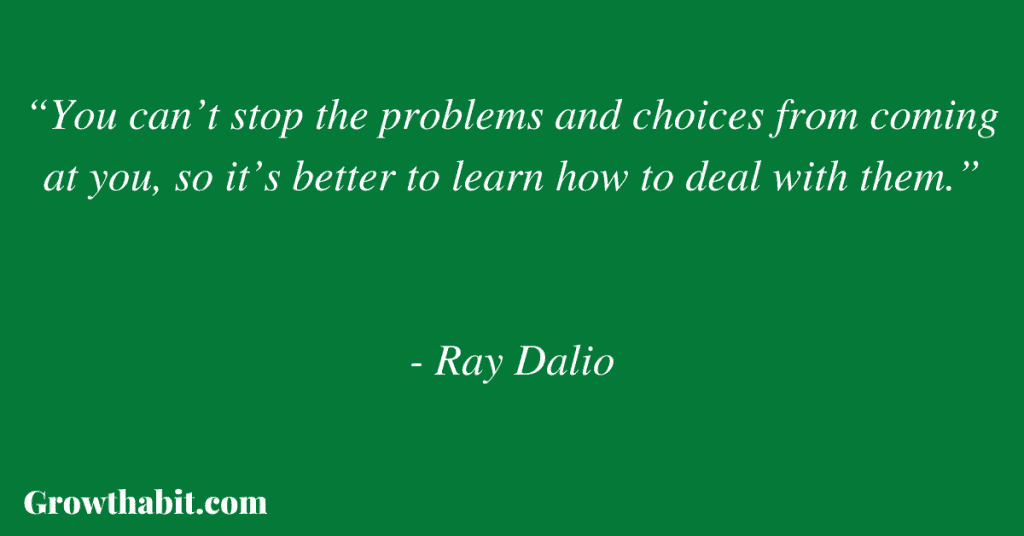
“163) Put Things in Perspective”
“164) Go back before going forward.”
“a) Tool: Have all new employees listen to tapes of “the story” to bring them up to date.”
“166) Design Your Machine to Achieve Your Goals”
“167) Remember: You are designing a “machine” or system that will produce outcomes.”
“168) Don’t act before thinking. Take the time to come up with a game plan.”
“175) Build your organization from the top down.”
“a) Everyone must be overseen by a believable person who has high standards.”
“176) Have the clearest possible delineation of responsibilities and reporting lines.”
“a) Create an organizational chart to look like a pyramid, with straight lines down that don’t cross.”
“181) Assign responsibilities based on workflow design and people’s abilities, not job titles.”
“186) Think clearly how things should go, and when they aren’t going that way, acknowledge it and investigate.”
“188) Do What You Set Out to Do”
“189) Push through!”
TO MAKE DECISIONS EFFECTIVELY…
“190) Recognize the Power of Knowing How to Deal with Not Knowing”
“191) Recognize that your goal is to come up with the best answer, that the probability of your having it is small, and that even if you have it, you can’t be confident that you do have it unless you have other believable people test you.”
“195) Constantly worry about what you are missing.”
“196) Make All Decisions Logically, as Expected Value Calculations”
“197) Considering both the probabilities and the payoffs of the consequences, make sure that the probability of the unacceptable (i.e., the risk of ruin) is nil.”
“198) Remember the 80/20 Rule, and Know What the Key 20% Is”
“199) Distinguish the important things from the unimportant things and deal with the important things first.”
“201) Make sure all the “must do’s” are above the bar before you do anything else.”
“202) Remember that the best choices are the ones with more pros than cons, not those that don’t have any cons. Watch out for people who tend to argue against something because they can find something wrong with it without properly weighing all the pros against the cons.”
“205) Synthesize”
“206) Understand and connect the dots.”
“209) Avoid the temptation to compromise on that which is uncompromisable.”
“210) Don’t try to please everyone.”
47) Recognize that the Type of Person you Fit in the Job must match the Requirements for that Job
How People’s Thinking Abilities Differ
“• There are two big differences in how people think that are due to the brain’s coming in two big halves and different people relying differently on them.”
“• Some people see details (trees), and others see big pictures (forests).”
“• Some people rely more on remembering what they were taught when making decisions, and others rely more on their independent reasoning.”
“• Some people are focused on daily tasks, and others are focused on their goals and how to achieve them.”
“• Some people are “planners,” and others are “perceivers.”
“Planners like to focus on a plan and stick with it, while perceivers are prone to focus on what’s happening around them and more readily adapt to it”
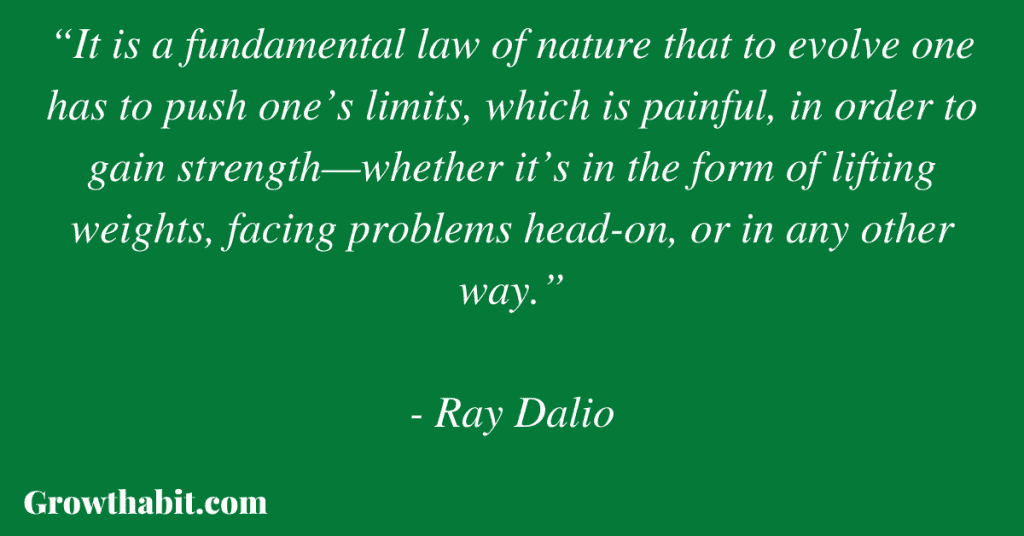
“• Some people are driven more by their emotions, and others are driven more by their intellect.”
“• Some people are risk-takers, and others are risk-averse.”
“• Some people are introverts, and others are extroverts”
Book Review (Personal Opinion):
This book is almost perfect and a detailed recipe for success. Dalio’s principles are priceless. They can inspire people to approach life in a more disciplined manner and improve all aspects of it.
Every single point and idea of the book is well explained. It backs everything with simple logic. In sum, it is quite comprehensive and insightful.
Rating: 9/10
This Book Is For (Recommend):
- Professional businesspeople striving to become better.
- Young people and students who are just starting their lives and careers
- Entrepreneurs who want to know what it takes to lead a successful company
If You Want To Learn More
The below link will take you to a video of Ray Dalio discussing his principles at Google
Google Talks
How I’ve Implemented The Ideas From The Book
I have tried to please people all my life. I have worked hard to be someone I am not just to conform. I have suppressed my creativity just to follow others.
This book has made me realize that I can only excel at what I want to and am meant to do. I am now trying to create my own path instead of the one carved by others because Principles has taught me to be original and an independent thinker.
It has helped me understand my own personality and how to make the most of who I am.
One Small Actionable Step You Can Do
Make a list of your weaknesses. Reflect on how they have stopped you from achieving your goals. Start working on the first weakness today.
